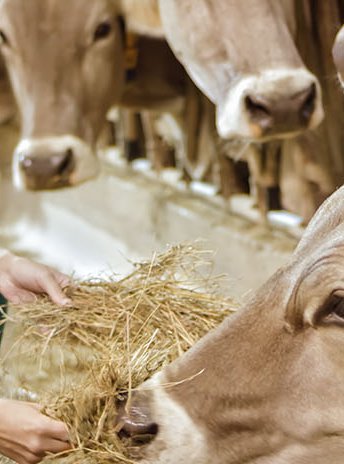Multi-species learning and research space for professional practice related to the veterinary care of livestock. Located on rustic land less than 8 km from the Campus of Villaviciosa, with a surrounding area of 3,000 m2, and easily accessed by a fully paved road.
The multi-species farm is an area that provides the animals with the necessary space—exceeding European recommendations—in every zone: common areas, the main building and individual livestock farms for different species (pigs, dairy cows, feeder calves, small ruminants, laying hens, broiler chickens and rabbits), with covered areas and outdoor pens or exercise yards, in addition to a canine area.
These facilities enable students—in both undergraduate and graduate degrees—to learn about health and farm management in realistic conditions. In addition, students can gain specialised knowledge on any of the housed livestock, as the facilities encourage their study and applied research.
This area provides support to the subjects covered in the study plan related to farm management, the health and production of common livestock species, as well as the subjects of Structure and Function (part of anatomical dissection), Complementary Diagnostics (part of necropsy and sampling), Veterinary Research and the Clinical Rotation of large animals and production in 5th year.
Learning and Research
The Learning and Research Farm facilitates important collaboration between veterinary medicine and medical research (Bachelor’s Degree in Medicine and Biomedicine). This enables experimentation in the animal unit, as well as research into its challenges—for example, experimental surgery on species comparable to humans, such as pigs, in multiple areas.
Innovation
Similarly, points of intersection are found in fields such as Biotechnology, with the development of livestock-based strategies such as the use of biogas, or the various applications of assisted reproduction, among others.
Sustainability
Likewise, the undergraduate degree in Environmental Sustainability is enhanced by the study of the implications of livestock practice on the environment, or the use of its by-products in agriculture.
The main building, in an enclosed hall, includes:
- Student and teacher support area: classrooms, lounge and study area for students and staff, and common locker room area
- Necropsy room and dissection area: a multifunctional space designed for the anatomical exploration of both large and small species in Veterinary Medicine, equipped with ten dissection tables and livestock containment equipment. It is also designed for the conservation and elevation of carcasses, and the preparation and conservation of animals and samples.
- Challenge and research area: pens in a controlled environment for applied research in small, medium and large species, as well as an animal experimentation unit.
Facilities for animals in realistic production conditions will be located on individual crofts, for semi-intensive agricultural use with outdoor exercise yards. In other words, the entire cycle of pig farming, dairy farming, feeding cattle, mixed production areas of small ruminants, laying hens, broilers and rabbits can be found in this facility.
Each livestock area will consist of its own operating zone (hose, scales, etc.), and the common area will contain the warehouse for raw materials, machinery, truck access and slurry pit.
The specific equipment for the Learning and Research Farm will include all the management and health equipment necessary for each housed animal species, as well as operating areas, furniture and machinery to ensure the best care for animals and the best educational experience. The facilities are arranged with all the biosecurity measures and animal welfare regulations necessary for professional practice, according to best practices for the handling of each species.
